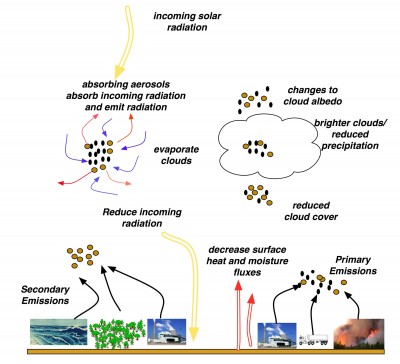
Light-absorbing aerosol particles contribute substantially to the net uncertainty in aerosol forcing of climate, despite their small abundance compared to non-absorbing aerosol particles. Their importance and influence on climate is directly linked to their ability to absorb solar energy, subsequently heating the atmosphere and, depending upon their vertical distribution, affecting atmospheric dynamics and cloud formation and dissipation.
In the Polar Regions, deposition of absorbing aerosols on snow can reduce the surface albedo, leading to accelerated melting. Previous studies have identified three main absorbing aerosol (AA) types: black carbon (BC), which absorbs throughout the solar spectrum; “brown carbon” (BrC), a type of organic aerosol that preferentially absorbs at shorter wavelengths, and mineral dust, which absorbs mostly at longer wavelengths. These types have distinct sources and hence distinct spatial and temporal distributions.
In recognition of the importance of this aerosol class in climate change, the Atmospheric System Research (ASR) Program of the U.S. Department of Energy (DOE) sponsored a two-day workshop that brought together 19 modeling and observational experts from within and outside of DOE, with the goals of identifying knowledge gaps and pinpointing research themes that can leverage the unique modeling and measurement capabilities available within the ASR Program and Atmospheric Radiation Measurement (ARM) Climate Research Facility to further our understanding of the climatological impacts of absorbing aerosols.
During this workshop, held in January of this year, four topical themes that ASR is uniquely positioned to address were identified:
- spatial and temporal distribution of AA and their impacts on the distribution of energy in the atmosphere;
- life cycle of absorbing aerosols from biomass burning;
- improved measurement and retrieval capabilities; and
- attribution of forcing to aerosol type (e.g., BC, BrC, and dust).
These themes will serve to further inform models and allow development of improved representations of AA processes and properties in models. In addition, the workshop reaffirmed the importance of and continuing need for expanded laboratory studies and field campaigns, and acknowledged that success in any of these themes is predicated on strong communication between the modeling and observational/experimental communities.
Finally, the synergy between the ARM measurement and ASR science strategies was recognized as a unique and powerful combination of complementary capabilities that will ensure that DOE will continue to actively contribute to the area of absorbing aerosol climate science and remain a leader in this field. A final report capturing the details of the discussions and findings is currently being written and is expected to be released to the public in the summer.
This work was supported by the U.S. Department of Energy’s Office of Science, through the Biological and Environmental Research program as part of the Atmospheric System Research program.

